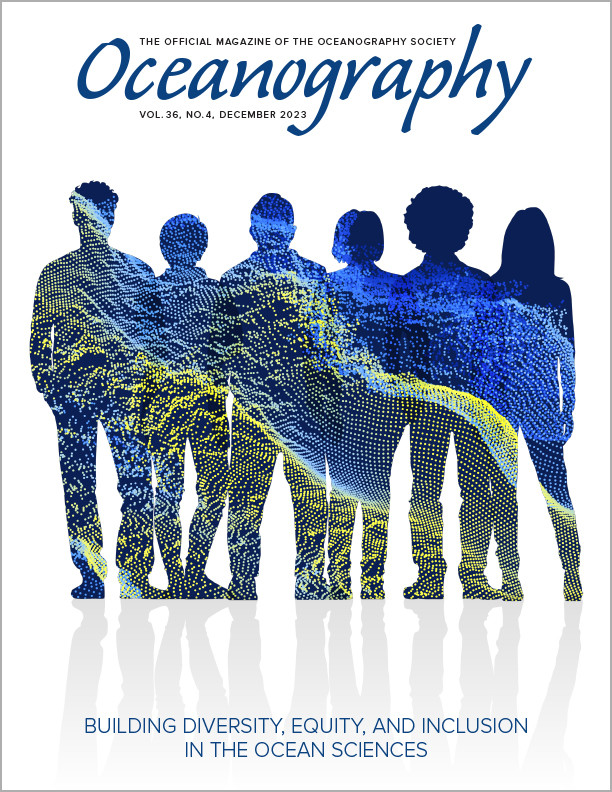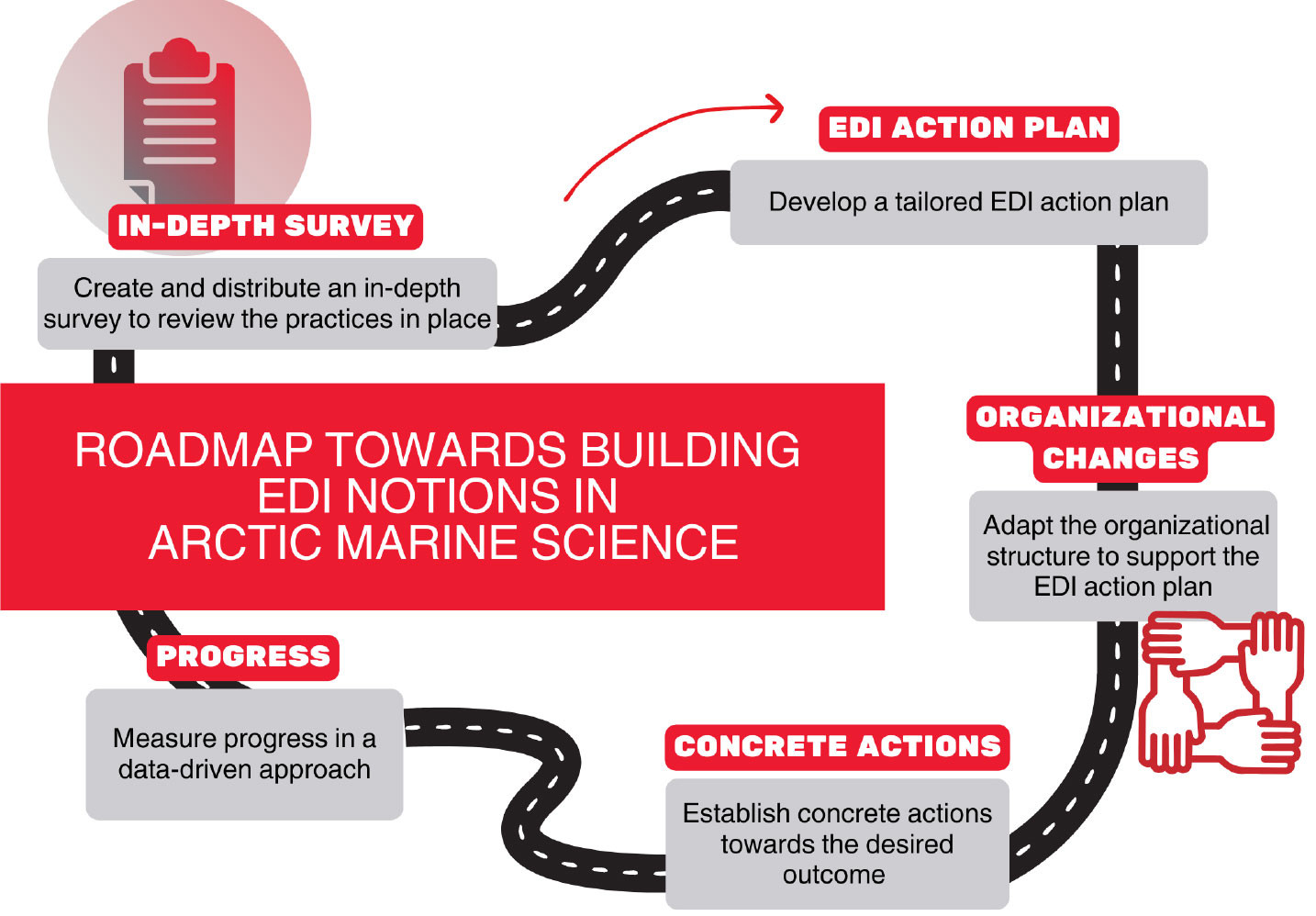Full Text
Introduction
As the organization managing the scientific mandate of the Canadian research icebreaker CCGS Amundsen, Amundsen Science aims to create a safe and respectful research environment for every expedition participant aboard the vessel and to improve our relations with stake- and rightsholders of the Canadian North. Our current focus is on two primary equity, diversity, and inclusion (EDI) objectives specific to Arctic oceanographic expeditions: (1) to make the confined and remote workplace of the ship a mentally, emotionally, and physically secure environment, and (2) to integrate Indigenous-led research and to bring awareness of local (Inuit) culture during the expeditions.
Program Description
The Canadian Coast Guard Ship Amundsen is Canada’s only dedicated research icebreaker, conducting annual scientific expeditions in the Canadian Arctic and sub-Arctic regions since 2003. Amundsen Science coordinates the expeditions and provides financial, logistical, and technical support to user programs from academic, public, private, and nonprofit sectors. In 20 years of operations, more than 1,850 individuals, researchers, students, and professionals have boarded the vessel (often more than once) to conduct their research programs. During a typical science mission, the Amundsen holds 80 passengers, comprised of 40 Coast Guard crew members and 40 scientists, thus creating a true microcosm within which building an equitable, diverse, and inclusive work environment is crucial. The scientific contingent includes a strong proportion of students (30%–40%), young professionals, and early career scientists, among whom approximatively 40%–50% identify as women. Amundsen Science is thus committed to implementing effective preventive measures and training that promote a social work environment free of bullying and harassment (e.g., Österman and Boström, 2022). In addition, given the inherent Arctic mandate of CCGS Amundsen as it sails in Inuit Nunangat territories, there is a strong need to bridge Indigenous and science-based knowledge (Tengö et al., 2014; Alexander et al., 2019).
Data-Driven Planning
Although building EDI has always been a key priority, increased efforts were invested in recent years through an in-depth review of our policies and practices that was initiated with a broad survey conducted by an external consultant in 2021. The anonymous survey targeted users of the vessel from 2015 to 2021 and was designed to measure their perceptions and lived experiences through an intersectional lens. It included a dozen statements about experiences onboard, to which responders were asked to rate their level of agreement. The questions covered a variety of topics, including representation in leadership positions, discrimination (lived and witnessed), the understanding of rights and obligations aboard, the clarity of reporting mechanisms, and the awareness or representation of Inuit culture during the cruise. One-on-one interviews were also conducted by the consultant with consenting participants in order to grasp their sense of belonging and to understand inequities that may occur on the ship, including the evolution of these aspects over time. The results of this survey were never directly shared with Amundsen Science in order to maintain the confidentiality of the survey participants, but insights gained were used to draft an EDI Action Plan, a key document identifying priorities and actions toward our EDI objectives for the coming five years.
The resulting EDI action plan highlights the need for:
- A clear executive and organizational commitment. Desired outcomes for this commitment include diversification of the Board of Directors (including gender equity), increased collaboration with Indigenous communities and research initiatives that benefit the North, and ways to measure progress in EDI. Creation of a diverse (culture, career stage, gender, etc.) EDI standing committee to help our organization move forward with implementation of the EDI Action Plan and key actions is also a central outcome from this commitment.
- The creation of a code of conduct that every individual boarding the vessel must sign. The code articulates expectations for conduct, consequences for poor behavior, and mechanisms for reporting any incident.
- An annual survey regarding EDI to provide invaluable feedback on safety and feelings of belonging and inclusion. This survey is an iterative process and aims at adopting a data-driven approach to EDI building.
- Facilitation of requests for accommodations in a confidential manner.
- The development of intersectional policies leading to an environment that centers on safety both on the vessel and in the organization’s office spaces.
Actions Undertaken
Although more work is needed regarding some of the actions described above, major steps have been taken since the adoption of the plan in 2021 during the first EDI committee meeting. First, we were able to implement a code of conduct for all scientific participants boarding the ship. This code of conduct was developed in collaboration with sister organizations in Canada (e.g., Reformar, ArcticNet) and follows the framework of the Canadian Arctic Research Code of Conduct (Ropars et al., 2023). One key change implemented aboard the vessel and described in the code is the identification of reporting mechanisms. In the past, conflicts within research teams or with the crew were solely addressed by the chief scientist and by the commanding officer. An external on-land confidential communication channel is now provided for reporting an incident. Coercive actions and accommodations, if needed, will be coordinated from the offices in Quebec City. However, fatigue, heavy workload, confined quarters, and proximity to colleagues are what we observe as the most frequent causes of friction and conflicts during the scientific cruises. Often considered as “small,” these issues do not tend to be reported and addressed, leading to the buildup of frustration. Therefore, a safe contact person is identified for each expedition segment to offer help, support, and guidance to participants in navigating these day-to-day issues. The safe contact person is usually an early career professional with experience on the vessel. These measures proved effective during the 2022 expedition and were positively received by the participants. Trainings will be offered for the safe contact persons over the next year.
During the scientific expeditions, CCGS Amundsen primarily sails in waters of Inuit Nunangat, the homeland of Inuit populations in Canada. Thus, we acknowledge that our operations should benefit local communities and their environment, and that research programs using our facility should take into account Inuit Qauijimajatuqangit (also referred as Inuit traditional knowledge), in accordance with the National Inuit Strategy on Research (Inuit Tapiriit Kanatami, 2018). Facilitating bilateral exchanges, deep cultural understanding, and Inuit self-determination in research are key objectives of our EDI Action Plan. We also aim to increase the number of Inuit-led and consultative research programs that access the facility. Actions supporting these goals were accomplished over the last years. In particular, we were able to strengthen a partnership with the Government of Nunatsiavut (coastal Labrador) that led in 2023 to the implementation of Imappivut, a large-scale marine research program driven by Inuit, from its conception to its realization, as one of the co-chief scientists of the cruise was Inuit. This program included a community visit in Nain (Labrador), where science participants and locals could discuss research findings and exchange information about their culture in the community and on the ship. We were also able to deploy moorings in Baffin Bay and in the Beaufort Sea to support local research objectives as well as to integrate several Inuit trainees into the scientific expedition, with Indigenous participants representing up to 4% of the annual scientific contingent (2022). Through the inclusion of Inuit participants and Inuit-led research programs aboard CCGS Amundsen, users of the facility have reported a greater connection to Indigenous culture and history than observed in surveys from previous years.
The shared management of the research vessel between Amundsen Science and the Canadian Coast Guard also provides unique opportunities to align priorities and allow quick changes in specific policies. For example, the Coast Guard developed a cultural awareness training for their shipboard crew at the same time as we were hoping to do the same for the science personnel. Efficient planning and collaboration allowed this training to be disseminated to all boarding personnel.
Conclusions and Lessons Learned
All research infrastructures and organizations have their own challenges and specificities. Although our EDI Action Plan is specific to Arctic marine fieldwork, we believe that the same roadmap could be applied by other organizations willing to review their EDI practices through various methods (e.g., surveys), strengthen their organizational structures through EDI standing committees, and iteratively develop their own action plans based on interactions with stakeholders, rightsholders, and users (Figure 1). It is crucial to take the first step and to review the practices in place as quickly as possible. Building EDI practices is certainly an iterative process that is not going to be perfect the first time, especially as much work is needed in the field. Most of the actions developed by our organization since 2021 are still being refined and will continue to evolve, yet positive impacts are already observed and will serve as a sound foundation as we continue to learn and act to enhance EDI during the scientific expeditions of CCGS Amundsen.
|
|


